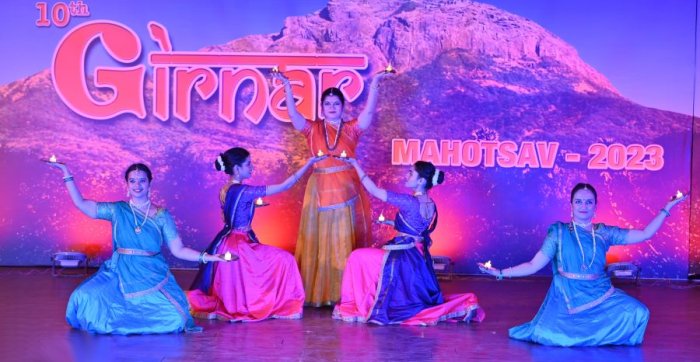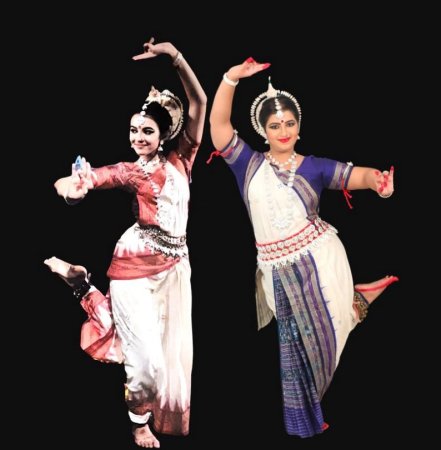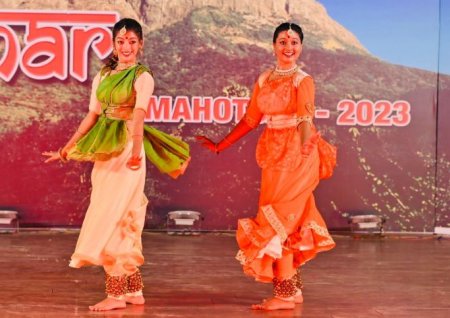
|   |

|   |
10th Girnar Festival of Music and Dance - Vijay Shanker e-mail: vijaydance@gmail.com January 20, 2024 The 10th Girnar Festival of music and dance was organised at the Shamaldas Gandhi Town Hall in Junagadh, near Rajkot in Gujarat from 1st to 5th December. This annual festival showcases the talent of upcoming artistes and established performers and is organised by MK Patel of Patel Cultural Foundation of Mumbai. While Bharatanatyam and Kathak dominated the festival, it was refreshing to witness Kuchipudi, Odissi and Mohiniattam performances too. The highlight presentation of the festival was the duet innovative choreography of Dr Prachi Jariwala in the Odissi style and Bharatanatyam by Himanshu Srivastava. Another unusual presentation was the combination of Yakshagana by Kiran Ullal and Bharatanatyam by Shravan Ullal from Mangalore. Some of the performances were quite remarkable. The festival commenced with Odissi by Bagmishree which unfortunately lacked the typical lyrical charm, which is the quintessence of this graceful dance style. Bagmishree performed 'Ganga Taranga' and 'Dashavatara' which was partially pleasing.  Aishwarya Harish The second dancer of the first day was Aishwarya Harish, the only one to perform Bharata Nrityam. She is the disciple and daughter of Guru Jayashree Rajagopalam, who is a senior most disciple of Dr Padma Subrahmanyam. Based on the composition of Tulsidas's Sri Ramcharitamanas, "Kankana kinkini noopuradhwani dhwani suni" incorporated some important episodes of the Ramayana like the Sita Swayamvaram and the 'Vatika Prasang', sung well by Harish and Aditya. It was interesting to witness the dramatization of the episodes, blending well with the movements, inclusive of charis, akash charis and karanas, forming a fine synthesis of music, rhythm and expressions with good command over the medium. It was a visual treat to watch Aishwarya dancing with effortless ease and precision.  Apoorva Wadke & group Mumbai based Apoorva Wadke Baksh is an accomplished Kathak exponent with several performances to her credit. Apoorva commenced her performance with the famous Gujarati poet Narsinh Mehta's interpretation of Krishna Vandana. She made a fine start along with her four disciples, followed with Talamalika and tritaal and chautaal which were performed with rhythmic accuracy. In the expressional segment, Apoorva performed a thumri "Tori may na manung" which explored the varied emotional states of the nayika as Mugdha, Madhyama and Prouda, while in a relationship with her lover. Apoorva and her disciples concluded the brief performance with Tatkaar, revealing their command over intricate footwork and layakari. Pune based Bharatanatyam dancer Seema Joshi created a fine impression with her immaculate performance. With invocations to Lord Ganapati and saint poet Gnaneshwar, Seema and her disciples made a good start, which was followed with Krishna Leela and concluded with the popular number "Sarasijakshulu" interpreting the naughty little Krishna and his relationship with mother Yashoda. In the abhang, it was interesting to note how maid servant Janabai considers Krishna as her friend, how the lord helps her in all the household work and how she ultimately attains sainthood due to her sheer devotion. The dancers concluded their performance with a brisk Thillana.  Anuja & Sanya The second day of the festival commenced with the pleasing Odissi performance by Anuja Padave and Sanya Kamani, disciples of Guru Asha Nambiar from Mumbai. They performed Kalavati Pallavi that exposed the typical characteristic movements inclusive of chauka, tribangis and charis with fine coordination and harmony, forming a fine synthesis of music, melody and rhythm. In the Odia composition "Ahe neela shaile", it was touching to watch the devotion of the Muslim poet Salabeg for Lord Jagannath and how he is redeemed of all his suffering due to his utmost devotion for the lord. The elegant performance was well received by the audience. Thane based Lakshmi Raj rendered a delightful performance along with her disciples. Lakshmi is the director of Natyaraj Institute of Fine Arts and is the disciple of Guru Lata Raman and Guru Suparna Venkatesh. Her performance impressed for its articulate movements and command over expressional dancing as well. The piece-de-resistance of her performance was Saptamatrika Varnam that explored the seven shaktis (feminine power) in the form of Brahmi, Vaishnavi, Maheshwari, Kaumari, Varahi, Narasimhi and Chamundi. It was an interesting display of the facets of the goddesses that included the benevolent aspect of the universal goddess and the virile and dominating aspect that fights against injustice to restore peace and harmony in the society. This number was in Shankarabharanam and created a lasting spell on the audience. Pune based Kathak exponent Yogendra Oze was supposed to perform a duet with Nilima Hirve but Nilima could not make it and it was interesting and surprising to see young Gandhali, daughter and disciple of Yogendra, rendering an enthusiastic performance. Yogendra is the disciple of Pandit Rajendra Gangani. He commenced with a choreography of Pandit Birju Maharaj, 'Ardhang' that portrayed the Ardhanarishwara concept of Lord Shiva and Parvati, revealing the masculine and feminine power and attributes in a concise format, executed powerfully. Besides the usual display of rhythmic pure dance sequences, the duo concluded the performance with a complex and musical Tarana.  Jhanvi Ambalia Ahmedabad based Jhanvi Ambalia's Kuchipudi performance was noteworthy for its vivacious quality and rhythmic movements with the typical bouncing movements of this dance style, that created a lasting impression on the audience. In fact Jhanvi was one of the youngest dancers to participate in this festival. She is the disciple of Guru Smita Shastri, director of Nartan School of Classical Dances. Jhanvi performed Manduka Shabdam that depicts how the frog is restored to the original position of being a beautiful maiden and the Balagopala Tarangam, dancing on the rim of the brass plate with rhythmic precision. Surat based Debasrita Mohanty is an accomplished Odissi exponent, who is in the Odissi dance faculty of Dayakerba Sangeet Vidyalaya. She commenced her performance along with four disciples with Mangalacharan, traditional invocatory number in praise of Lord Jagannath, followed with Abhinaya Chimpu "Leelanidhi hey" establishing the intense relationship of Radha and Krishna and gopis with relation to the leelas of Krishna and the description of the multi-facets of the lord. The artiste danced with fine coordination, harmony and natural command over abhinaya. Thane based Devika Mankar and Pranjal Kolhe are the disciples of Kathak exponent Mukta Joshi. It was a pleasure to watch the duo performing with confidence and effortless ease. They were pleasing in two interpretative numbers, describing two varied aspects of Lord Krishna - as the naughty Krishna in "May ghunghat oda chali" and as the lord for the saint poetess Meera in "Pug ghungroo bandh, Meera nachi re". The duo created a fine impression with the precise and accurate rendering of the Tarana.  Devika Mankar and Pranjal Kolhe  Wincy Fernandes The only Mohiniattam dancer of the festival, Wincy Fernandes is the disciple of Ayswaria Wariar based in Vadodara. After the traditional Ganpatiye, Wincy performed an ashtapadi in Mohana ragam. Wincy was quite elegant in her performance but one can definitely expect more from her in the future.  Anupama Harshal and group Dr Anupama Harshal along with nine dancers performed Kathak with a lot of enthusiasm and confidence. The dancers were Apoorva Damle, Punam Labane, Prerana Haveri, Edna Albukark, Depali L Japadia, Rekha Singh, Mohima S Rathod, Arushi Harshal and Kavya Jain. After the Guru Vandana, the dancers performed the rhythmic and blissful 'Raas taal' in which the dancers perform in a circular pattern, followed with "Kajri barsan lagi badariya", signifying the onset of the monsoon and romantic mood that is induced along with "Lagi re lagan chitchor" that involves the beauty of nature and its colourful facets.  Prachi Jariwala & Himanshu Srivastava Prachi Jariwala and Himanshu Srivastava in a duet presentation combined the beauty and elegance of two styles, Odissi and Bharatanatyam in an interpretative number 'Baazi'. Radha and Krishna as penned by Raskhan, a bhakti kaal poet, visualises them meeting first as two rivals. While Krishna interrupts Radha's route and demands tax, Radha mocks him and his odd behaviour. Soon the rivalry turns into a challenge in the game of dice, where all is lost to win it all. With script and research by Himanshu, music by Keerthana Krishnamurthy and choreography by Himanshu and Prachi, it was a fine experimental exercise, maintaining the beauty of both the styles where the gestural language took the upper hand. It was an enjoyable experience for the audience.  Kiran & Shravan Ullal Another unusual presentation of the festival was the combination of Yakshagana and Bharatanatyam. In Yakshagana that's inclusive of vachika abhinaya, Kiran Ullal appears as Kansa and later as Poothana in the story of Krishna. Shravan Ullal appears as the little Krishna who eventually kills both Poothana and Kansa. While the soft movements were used by Shravan in the Bharatanatyam style, Kiran in the Yakshagana style was noteworthy for his vibrant and forceful movements. There were some lighter moments too when Poothana looks in the mirror and is aghast with her deadly face and when the infant Krishna urinates on Poothana and she is disgusted. On the whole it was an entertaining and enjoyable performance by both the artistes. Mumbai based Aditi Yadav and Radhika Phanse presented a pleasing Kathak duet, revealing the footwork precisely with intricate rhythmic patterns. Smita Nair and Binduja Nair rendered a sparkling Bharatanatyam performance, commencing with Mallari and another number in praise of the goddess Rajarajeshwari and Durge. It was a pleasure to witness the clarity of movements and the overall command over the technique and expressions. The last dancer of the festival was Rajkot based Kathak dancer Khyati Mer, who performed with her disciples, commencing with Durga Stuti. They danced in teen taal and presented some compositions choreographed by Guru Puru Dadhich. The dancers created a fine impression with their enthusiastic performance. On the whole it was an interesting festival with some wonderful dancers.  Vijay Shankar is a Kuchipudi and Kathakali exponent, teacher, bilingual journalist, arts critic and actor. |